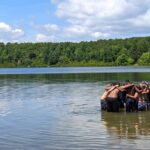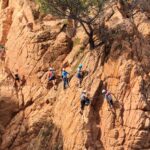Rock climbers in a remote Wyoming canyon may help shape national public lands climbing management
By Nita Tallent
On an early summer day in 2018, a group of sport rock climbers—packs laden with ropes, quickdraws, harnesses, shoes, and chalk—clambered up a makeshift trail in Tensleep Canyon, Wyoming. They were eager to ascend the steep, awe-inspiring limestone walls strewn with pockets, cracks, ledges, jugs, and crimps that promised to deliver challenge and exhilaration.
 “We noticed some excessive use of glue in routes at a really well-established area up in Mondo-Beyondo,” recalls Mike Ranta, cofounder of the Tensleep Canyon Aerospace Society. “We had no judgement on that at the time.” However, their opinion began to shift when they saw how many new routes included holds manufactured through chipping, drilling, and gluing the rock. Such manufacturing is anathema to standards for climbing route developers to “leave the rock in as close to its natural state as possible.”
“We noticed some excessive use of glue in routes at a really well-established area up in Mondo-Beyondo,” recalls Mike Ranta, cofounder of the Tensleep Canyon Aerospace Society. “We had no judgement on that at the time.” However, their opinion began to shift when they saw how many new routes included holds manufactured through chipping, drilling, and gluing the rock. Such manufacturing is anathema to standards for climbing route developers to “leave the rock in as close to its natural state as possible.”
A booming popularity in the area alongside ambiguity over what constitutes ethical route development has made Tensleep Canyon the stage for an outdoor recreation conflict. Now, as the Bighorn National Forest resumes work on a climbing management plan for Tensleep Canyon to both address issues associated with overcrowding and define what amount of rock alteration is allowed when developing climbing routes, climbers and public land managers around the country are watching closely. The Tensleep Canyon Climbing Management Plan has the potential to set precedent for rock climbing management on public lands nationally.
~
Tensleep Creek cuts through an evergreen shrouded canyon down the southwest face of the Bighorn Mountains in northcentral Wyoming. Climbers have scaled the towering limestone and dolomite cliffs of Tensleep Canyon since the early 1980s when the “godfather” of Tensleep, Stan Price, hand drilled and installed ten bolts to set “Home Alone,” one of the first sport routes in the canyon. Hours from any major airport and lacking the glamor of Yellowstone and Grand Teton National Parks, residents and recreators believed the canyon was immune from being overrun. However, in the 30-plus years since rock climbers with ropes saddled over their shoulders first burrowed into these forests, word of the canyon as a treasure chest of routes waiting to be established spread.
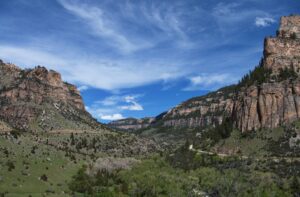
Since the 1980s, climbers have developed more than 1,200 climbing routes in the Tensleep Canyon area. After local climber Aaron Huey and others compiled The Mondo Beyondo: Tensleep Canyon, Wyoming, the first published guidebook to the canyon in 2008, climbers and route developers flocked to the area. Today, climbers from around the world have discovered the canyon, making it the central jewel in the crown of any self-respecting sport rock climber. Still many local climbers would have preferred the jewels stay a secret.
The surge in popularity has brought problems. Heavy traffic and illegal parking along the Cloud Peak Skyway (Hwy 16) and Forest Road 18 create safety concerns. A weaving network of unapproved trails to crags is eroding soil. Dispersed camping sites close to waterways and the road are on the rise. Uncontrolled dogs run amuck. Masses of climbers inadvertently spread invasive plant species such as houndstongue and Canada thistle in addition to leaving behind human and pet waste and litter. At the base of climbing walls, staging areas have compacted soil and damaged shrubs and grasses. Boisterous crowds interfere with nesting raptors.
Recognizing that recreation was on the increase, in 2005 the Bighorn National Forest published a Forest Land and Natural Resource Management Plan announcing that within 10 years a climbing management plan would, “inventory existing rock-climbing routes including approach, associated trail locations, and human impact,” in Tensleep Canyon.
In 2011, the Access Fund, a national climbing advocacy organization, created a Tensleep Canyon stewardship group, now known as the Bighorn Climbers’ Coalition, to work with the Bighorn National Forest on the climbing management plan. The Access Fund’s goal was to collaboratively develop a plan “that both preserves the current climbing experience at Ten Sleep [sic], while conserving the resource for future generations.”
However, 2015 came and went and the promised plan had yet to be created. By the time Ranta and his buddies witnessed manufactured holds and chipped rock in Tensleep Canyon in 2018, it was not unusual to find climbers from around the world crowding at the base of the crags, anxiously waiting their turn. In that same year the Access Fund included Tensleep Canyon as one of “10 Climbing Areas in Crisis,” noting that “world-class climbing” invited crowds too great for the area to sustain.
~
As the popularity of rock climbing grew in Tensleep Canyon, so did the number of route developers looking to leave their mark on the limestone walls. This was not without controversy. For those not in the climbers’ sphere, establishing a new route is the magnum opus for many climbers, the pinnacle of their progression and status in the climber community. Setting or developing a sport rock climbing route involves drilling holes into the rock and inserting bolts along an ideal line that is safe and appropriately challenging. Ideally, route setters do this with minimal impact to natural geology, flora, and fauna of the rock face. They may “clean” the route, which generally involves brushing aside loose rock, vegetation, debris, lichens, and moss. They may also “comfortize” hand holds by smoothing and sanding sharp edges typical of the Bighorn Mountains to minimize torn and bloody “climbers’ hands.”
Generally, cleaning and comfortizing in dolomite and limestone are considered acceptable modifications by modern climbers, but the “manufacturing” Ranta and his buddies encountered in 2018 is not. The Access Fund defines manufacturing (a practice which they oppose) as “any conscious attempt to expand a hold, create a new hold (drilling pockets, expanding a pocket with a tool, creating a hold with glue), reinforcing loose holds with glue, or adding/placing an artificial hold on the wall in an attempt to curate a climbing movement or experience, or to create a route other than what is naturally available.” The conundrum is in the fine line between “cleaning and comfortizing,” which many climbers accept, and “manufacturing,” which many climbers oppose.
In an attempt to self-regulate in Tensleep Canyon, Ranta and other climbers approached world-renowned route developer and owner of a nearby climber campground Louie Anderson, who they suspected of manufacturing. The actual words exchanged during the June 30, 2018, meeting are forever lost with only contradictory recollections remaining. The gist was to agree upon what was and was not acceptable for comfortizing routes in Tensleep Canyon and put a stop to manufacturing. However, route manufacturing continued.
The Bighorn Climbers’ Coalition and the Access Fund denounced the manufacturing. In addition, three original Tensleep Canyon route developers—Charlie Kardaleff, Aaron Huey, and JB Haab—posted an open letter condemning the practice on the Tensleep Canyon Facebook page. Taking the debate to a national audience, Rock and Ice magazine published the letter in 2019. In addition, citizens reported the damage caused by the manufacturing to the Forest Service believing that it was the Forest Service’s role to stop the practice.
In July 2019, a few climbers, frustrated by the Forest Service’s failure to police the manufacturing, closed manufactured routes by removing bolts, clipping bolts flush with the rock surface, filling holds with glue, and affixing bright red padlocks to the lowest bolts. If the intent was to generate a reaction, that intent was met. The Forest Service, the Access Fund, and Bighorn Climbers’ Coalition quickly condemned the bolt cutting and padlocks, which escalated tensions and further divided forest users.
On July 19, 2019, much to the dismay of many in the local and national climbing community, Powder River District Ranger Traci Weaver issued an official regulation prohibiting any new route development until release of the Forest Service’s long-promised climbing management plan (which was slated to be completed by 2015, yet still in 2019 nowhere to be seen). Soon after Weaver’s announcement the Access Fund released a statement which denounced both route manufacturing and “vigilante bolt chopping” forecasting concern that due to these actions the “climbing community could lose the privilege of climbing in Ten Sleep [sic] altogether…”
Eighteen months later the Powder River District held a virtual meeting to request input from the public about climbing in Tensleep Canyon. The goal was to identify desired condition of the forest and clarify practices that would ensure respect for the natural and cultural resources owned by all Americans yet entrusted to the care of the US Forest Service. During this February 2021 meeting, District Ranger Weaver announced that the Bighorn National Forest had contracted Maura Longden, climbing management consultant with High Peaks, LLC, to lead development of the Tensleep Canyon Climbing Management Plan.
Members of the public submitted over 500 comments both during the public meeting and in response to a scoping notice, summarized on the Bighorn National Forest National Environmental Policy Act planning web page. The public expressed a gambit of concerns ranging from the fear that the Forest Service would prohibit all forms of rock climbing; to concerns about negative impacts to natural and cultural resources; to questions about the absence of non-climber, outdoor, recreator, Indigenous, and diverse perspectives in the discussions; to other issues. The overarching concern was whether and how the Forest Service would curtail route manufacturing while allowing route development to resume.
~
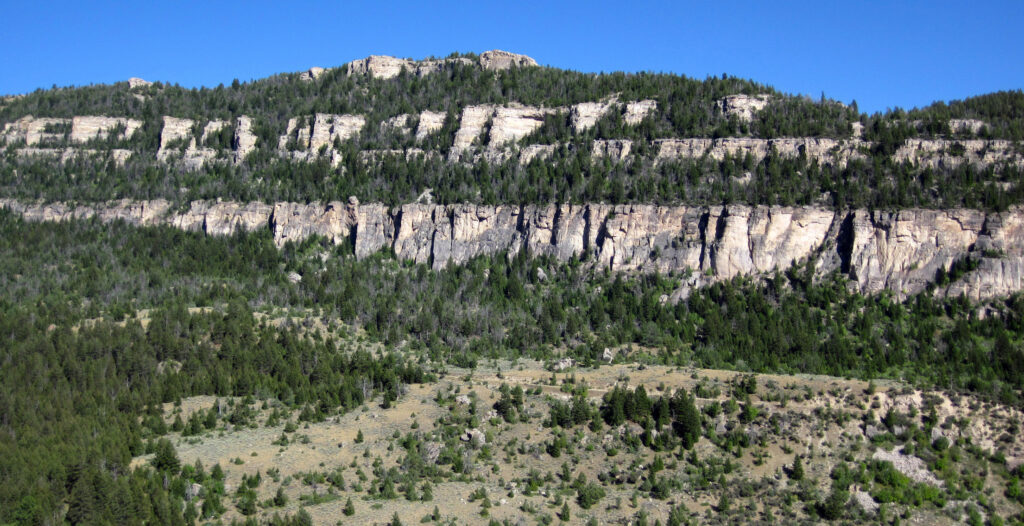
Despite the Forest Service’s best intentions, effort on the climbing management plan paused again following Weaver leaving her position in June 2021. In 2022, a new leadership team joined the Powder River District. District Ranger Thad Berrett, Lead Climbing Ranger Ryan Sorenson, and Recreation Program Manager Kelsey Bean began reaching out, learning about the needs of the many forest users, and signaling that efforts on the stalled plan would resume.
In 2023, the Powder River District staff continued to familiarize themselves with issues and the stakeholders, rights-holders, and national interest groups as they resumed work on the Tensleep Canyon climbing management plan. According to the Forest Service’s web page, the plan will respond to “increased development and impacts from rock climbing,” and will entail protections for soil, vegetation, geology, water, cultural resources, wildlife, and social resources. The Forest Service confirms it will codify the route development practices and ethics outlined in Best Practices for Development and Rebolting in the Bighorn Mountains and Bighorn Basin, a document the Bighorn Climbers’ Coalition and Access Fund created with the Forest Service, while prohibiting manufactured holds and routes. It will also guide management for access trails and staging areas, human and pet waste, dog and human interactions with wildlife and livestock, commercial use, gear caches, dispersed camping, and visitor capacity. Climbing management plans are subject to the National Environmental Policy Act, which will allow for public participation. Ranger Berrett acknowledges that momentum on the plan has been slow and says not to expect implementation until 2024.
Meanwhile, US Forest Service leadership and climbing advocacy organizations such as the Access Fund are following the Tensleep Canyon Climbing Management Plan because it has the potential to set precedent for rock climbing management on public lands nationally. Despite the fact that 30 percent of climbing in the United States occurs in national forests, there is no national policy defining acceptable, standard practices meaning each of the more than 150 national forests must establish their own policies. The Access Fund is advocating for nation-wide guidance to bring “consistency and stability” among national forests. Eyes are on how the Bighorn National Forest codifies climbing in Tensleep Canyon because this climbing management plan may pave the way for other forest plans as well as national policy.
In addition, two bi-partisan bills put forward in Congress have the potential to shape management of fixed climbing anchors across designated Wilderness areas on public lands, according to the Access Fund. The Protecting America’s Rock Climbing Act (H.R. 1380) from Representatives Curtis (R-Utah), Neguse (D-Colorado), and Stansbury (D-New Mexico) and the America’s Outdoor Recreation Act (S. 873), introduced by Senators Barrasso (R-Wyoming) and Manchin (D-West Virginia) intend, in part, to “bring consistency to federal climbing management policy and protect some of America’s most iconic Wilderness climbing areas,” as summarized by the Access Fund. Both bills direct public land managers “to outline any requirements or conditions associated with the placement and maintenance of fixed anchors on federal land.” They also would require agencies to solicit public comment when drafting the requirements, giving climbers a voice in shaping climbing practices on public land.
~
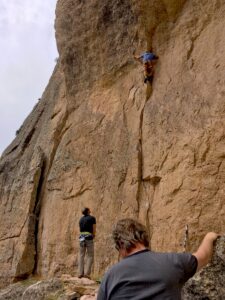
As they await the final climbing management plan, an unofficial local climber group is promoting ethical climbing and route development. The Tensleep Canyon Aerospace Society, led by Mike Ranta and Adam (Ace) Ashurst, creates updated editions of Aaron Huey’s original climbing guide. In 2023, this informal collective completed the Tensleep Canyon Climbing Guidebook 11th edition: The Invasion, which explicitly opposes the “intentional alteration of the rock by chipping, drilling pockets, or gluing for the purpose of enhancing holds (manufacturing).” The society’s strategy is to call out manufactured routes so local and visiting climbers can avoid or boycott them out of respect for the landscape, sending the message that manufactured routes are not to be revered or tolerated.
The Bighorn Climbers’ Coalition is also doing its part to engage climbers in stewardship of Tensleep Canyon. The coalition’s Christa Melde invites everyday climbers of all colors, genders, sexual orientations, and ethnicities to join the conversation around the climbing management plan. She believes the solution to sustainable climbing in Tensleep Canyon “just boils down to education.” To that end, Bighorn Climbers’ Coalition members reach climbers through one-on-one conversations about stewardship and Leave No Trace practices at crags and trailheads. They also advance engagement and education at the annual Tensleep Climbers’ Festival each July.
Everyone who Western Confluence spoke to for this article—the Bighorn Climbers’ Coalition, the Access Fund, a permitted rock-climbing guide, the Tensleep Canyon Aerospace Society, and independent, unaffiliated climbers—expressed a spirit of renewed enthusiasm and cooperation, unanimously pledging their support to the Forest Service staff in completing the climbing management plan. Now, land managers and climbers around the country are watching to see how the Bighorn National Forest not only tackles the challenges of parking, camping, trail use, and waste disposal in a remote yet world-famous climbing destination, but also how they draw the line between ethical route development and forbidden manufacturing.
Nita Tallent, PhD, is a plant ecologist, retired federal natural resource professional, and a master’s student in the Haub School of the Environment and Natural Resources at the University of Wyoming. Her current research focuses on the motivations of private landowners to allow outdoor recreationists on their lands. Nita is also an avid outdoor recreator who dabbles in sport rock climbing.
Disclosure: Adam (Ace) Ashurst of the Tensleep Canyon Aerospace Society is the author’s step-son.
Header image: A rock climber ascends a sport route in Tensleep Canyon, Wyoming. (Photo by Nita Tallent.)

